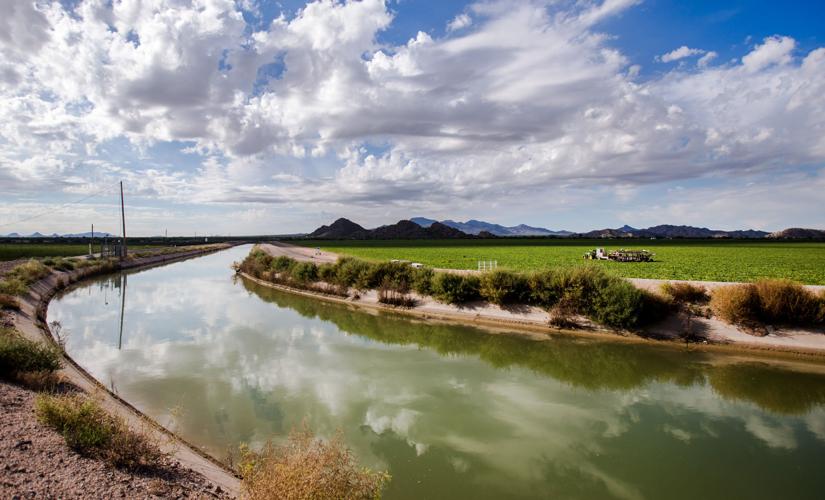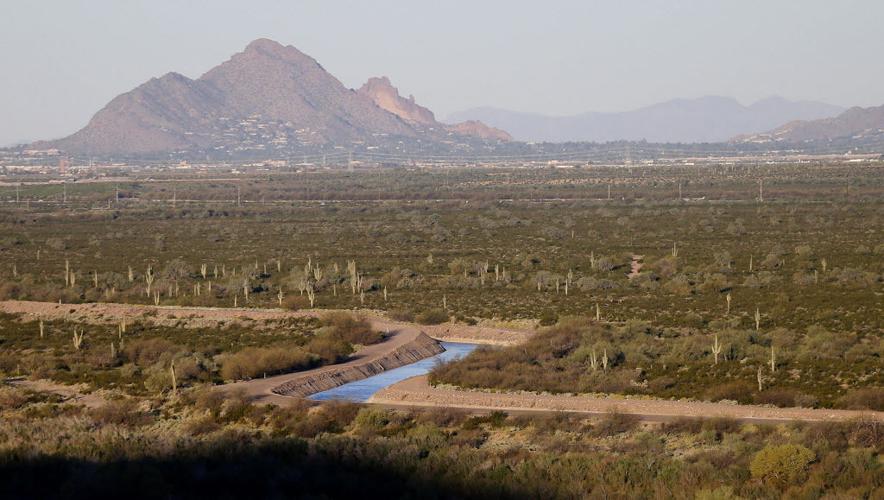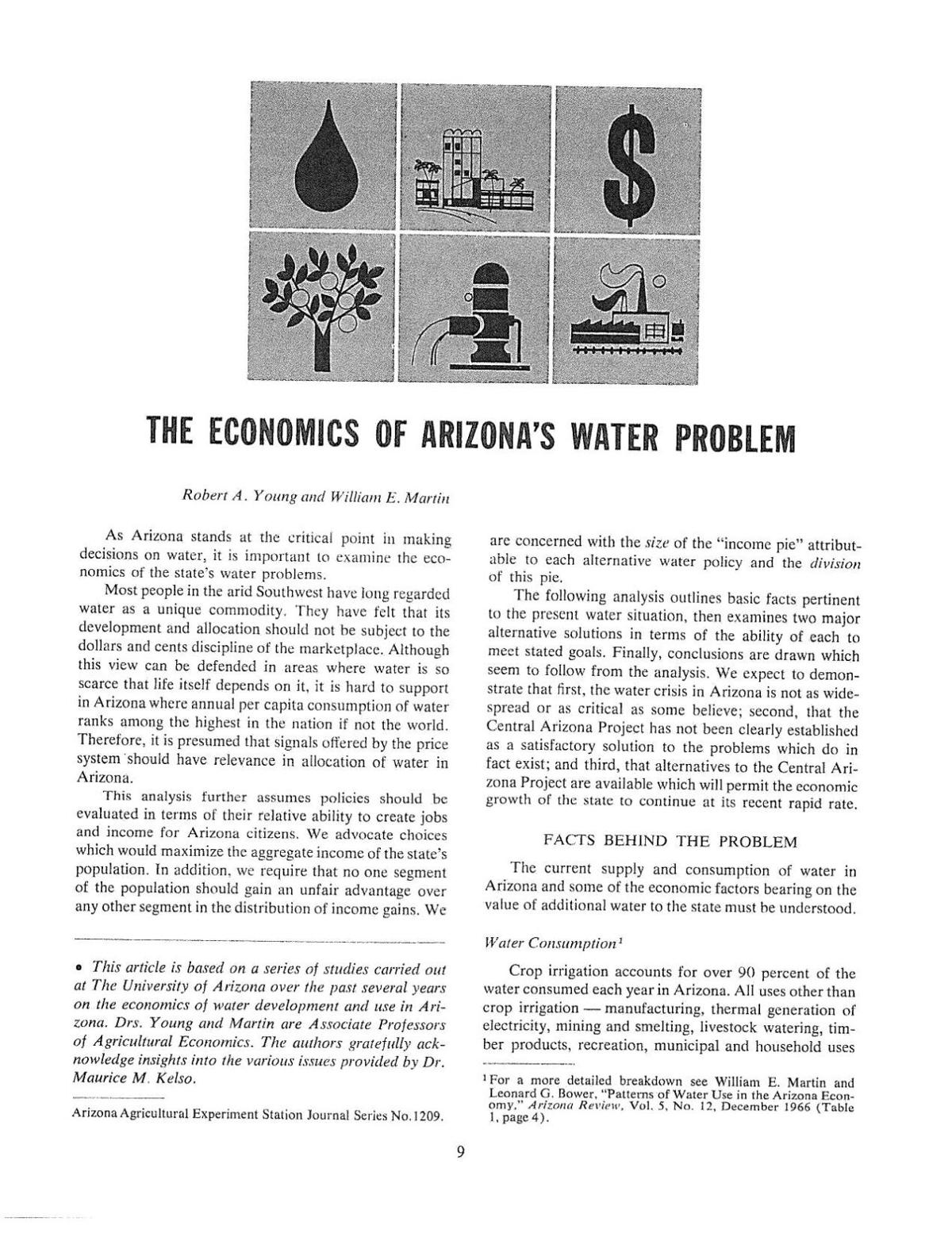Fifty-three years ago, University of Arizona agricultural economist William Martin was a prophet without honor in his state.
A March 1967 study he co-authored, questioning the need for the Central Arizona Project and warning that Arizona farmers could not afford its water, got him blasted by his fellow academics and by public officials, in a state that was battling in Congress to get the project approved.
Arizona Daily Star editorials called the study “anti-Arizona propaganda” and said it did the state a “great disservice, under the guise of academic freedom.” A fellow UA economist was commissioned by the university’s agriculture school dean to rebut the research.
But upon his recent death at age 87, Martin was remembered by many friends and colleagues as a blunt, forthright, outstanding researcher. Most importantly, they recalled his forecast was on the money about the big federal water project’s impact on Arizona agriculture.
Martin died Sept. 18 at his midtown Tucson home, where he lived with Jean Martin, his wife of 37 years and a retired UA art professor.
Message wasn’t what state wanted to hear
CAP was sold to Congress in part as an agricultural lifeline that would give them an alternative to relying on declining underground aquifers for their survival. But by the time CAP — whose cost ultimately hit $4 billion — was ready for farmers in the late 1980s, most couldn’t afford its water at the price offered.
That led to an economic crisis that put CAP on the edge of financial collapse until deals were cut to give them subsidized, low water rates.
“He was very meticulous in what he did. His research has stood the test of time,” said Russell Gum, a longtime friend of Martin’s and a former colleague as a retired UA agricultural economics professor. “It took a while for people to recognize his research on CAP was right on track, but they did.”
His message was not what the state wanted to hear, said Robert Glennon, a UA law professor and author of two books about water, including “Unquenchable,” a book warning of an impending water crisis due to wasteful use.
“For four decades, Arizona was fighting to get the CAP, and along come these two pointy headed academics saying that it’s not going to benefit the farmers,” said Glennon. “You just could not be a politician and for that matter an academic in the 1960s and ’70s and not be in favor of the CAP.”
Contrarian amused by contradictions
A natural contrarian, Martin spent decades writing papers exploring and criticizing Arizona’s water use, particularly that of farmers. But he was far from an environmentalist.
In the 1980s, he clipped the word “Wisely” from a “Use Water Wisely” bumper sticker on his car, to show his disdain for traditional water conservation practices. His home contained a front, back and side yard — all grass.
In 1984, he co-authored a book, “Saving Water in a Desert City,” that said Tucson’s water rates were too low to send the right signals about water availability. The book argued the only real purpose of water conservation in Tucson was to ensure there would be enough water to allow continued growth — an argument that drew passionate criticism from conservationists.
“He found these contradictions to be very amusing. He looked at the facts and peoples’ inability to see them. But instead of getting morally outraged, he was amused,” recalled Helen Ingram, a UA research fellow and retired professor who collaborated with Martin on that book and other works. “His common thread was that he was going against the conventional wisdom, not in a cranky way, but in a playful, amusing way.”
Also, Martin was hardly anti-agriculture, his friends and family said. Born in Modesto, California, in 1933, he moved with his teacher parents to a nearby small peach farm in 1942. Martin worked on the farm and in high school, and was active in Future Farmers of America.
In the 1950s, he earned a bachelor’s degree from the University of California-Davis and a doctorate in philosophy from the University of California-Berkeley, and he joined the UA faculty as an assistant professor in 1961.
Over time, his writing won numerous awards and earned him a Fulbright Scholarship.
His writings were nationally known
An admiring interviewer in the 1980s portrayed him as far from the stereotypical scholar.
“Large and bearded, inclined toward jeans, cowboy boots and western shirts, Martin looks as if he would feel more at home in the cockpit of a Peterbilt than at a professor’s desk, even if his writings are nationally known,” author Marc Reisner wrote in the book “Cadillac Desert,” his 1986 classic, investigative assault on the CAP and many other Western water projects.
Reisner focused on the 1967 study, “The Economics of Arizona’s Water Problem,” that got Martin and his co-author, UA professor Robert Young, so much heat.
They noted agriculture used about 90% of Arizona’s water but produced only 3% of its total income. They found well over half of Arizona farm water was used to irrigate lower-value crops such as feed and forage, thus reducing the water’s value.
While farmers would get their CAP water at $10 per acre foot, compared to $50 per acre foot for Tucson and Phoenix, even that subsidized charge — plus a lesser charge for paying for canals to take water from the main CAP canal to farms — would exceed their expected earnings, the two wrote.
“Such a loss could not be sustained indefinitely,” the researchers concluded in examining what they saw as a typical Central Arizona farmer. “Since his net returns would decline more rapidly with higher cost project water than with pumped water, the farmer would be forced out of business much sooner.”
Cities also would be worse off economically with CAP because its cost was also a lot higher than pumped groundwater, they wrote. While the state’s groundwater basins were being rapidly depleted by over-pumping, they concluded that 170 years worth of recoverable groundwater remained statewide.
They suggested using the CAP water close to the Colorado River, at lesser cost. While farming in the state’s interior would keep declining, the decline would be slow, because as pumped groundwater got more expensive, farmers would use it more wisely, they said.
Overall, “the water crisis in Arizona is not as critical or widespread as some believe,” they wrote.
Revolutionary for its time
In the context of Arizona’s fight to get CAP authorized — which happened in 1968 — Martin and Young’s work seemed “as revolutionary as Das Kapital,” Reisner wrote, referring to Karl Marx’s 19th century critique of capitalism.
UA agricultural economist George Campbell quickly issued a report countering Martin and Young’s findings. Among many other things, the two did not really prove the presence of 170 years worth of groundwater, and their “typical” farms unable to afford CAP water were not typical, Campbell said.
As Martin’s colleague Russell Gum recalls, the Arizona Legislature considered legislation to cut off UA’s funding unless Martin, Young and Gum were fired, although it never became law.
Reisner’s book and Ingram both said Martin was denied raises for eight years after that study was published.
Young later left the UA for a job in Colorado, at least in part due to fallout from that study, recalled several researchers.
In the 1980s, Martin wrote more prophetic studies, showing that Central Arizona farmers were willing to sign up for CAP water despite its cost because they knew that when it came time to pay the bills, the costs would be renegotiated with the federal government.
In the 1990s, farmers began dropping out of the project, and irrigation districts to which they belonged began to go bankrupt.
To keep farmers in the water project, the state and the feds twice gave CAP farmers significant price breaks, supported by subsidies from other users. Their debts on federal loans to build canals to individual farms were forgiven. In 2004, in return, the irrigation districts agreed to give up their CAP contracts, and to stop using CAP water entirely by 2030.
Retired UA agricultural economist Paul Wilson wrote two studies in the 1990s that backed up Martin’s findings.
Legacy, remaining issuesMartin left UA in 1989 as he and his wife, Jean, took posts at universities in Illinois. After retiring in 1992, the couple spent 19 years on an Illinois farm, raising animals including checkered giant show rabbits.
Besides Jean, and his previous wives, Mari Lane and Marjorie Ashcroft, Martin is survived by a sister, Ann M. O’Leary, two daughters, a son, six stepchildren and 16 grandchildren. Because of COVID-19, memorial services will be delayed until travel is safe, Jean Martin said.
As for the farmers who once reviled Martin’s work, many if not most are now deceased.
A longtime Pinal County farmer, Dan Thelander, and a retired irrigation district executive, Brian Betcher, said they do not recall Martin’s research but agreed that CAP’s original price was too high for farmers to survive.
At its current price, however, CAP has been an economic boon for farmers and the entire state while reversing a decades-long decline in area aquifers, they said. Statewide, the agency that runs CAP estimates the project has generated $3 trillion in economic benefits due to the development it enabled over the years.
The lower water prices enabled Arizona to keep CAP water in use, stopping California from taking it, Thelander recalled.
“It has really extended agriculture’s life in Pinal County,” said Betcher, former general manager of the Maricopa-Stanfield Irrigation District. “If you have a resource like groundwater, even though levels were declining, if CAP was going to cost more than that, what’s the incentive to stop pumping?”
All this could change when CAP shortages begin, with cuts in water deliveries to farmers possible starting in 2022, and deepening over the next few years.
Then, the second half of Martin’s 1967 thesis —that Arizona can survive economically without CAP — will get its first test.
How William Martin's CAP objections played out in the press
"Underground supply will last 170 years," Arizona Daily Star, March 17, 1967
Updated
Editorial: “Flaws in the Young-Martin Article," Arizona Daily Star, April 3, 1967
Updated
"Young-Martin Thesis Faulty, Says Campbell," Arizona Daily Star, April 4, 1967
Updated
"Two professors say use lots of water; don’t be guilty about pool, lawn," Tucson Citizen, Aug. 3, 1983
Updated
"Ex-UA professor predicted CAP crisis in 1967," Arizona Daily Star, Dec. 2, 1992
Updated









